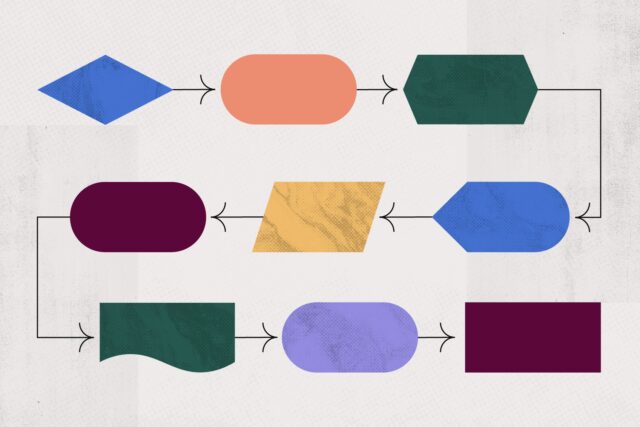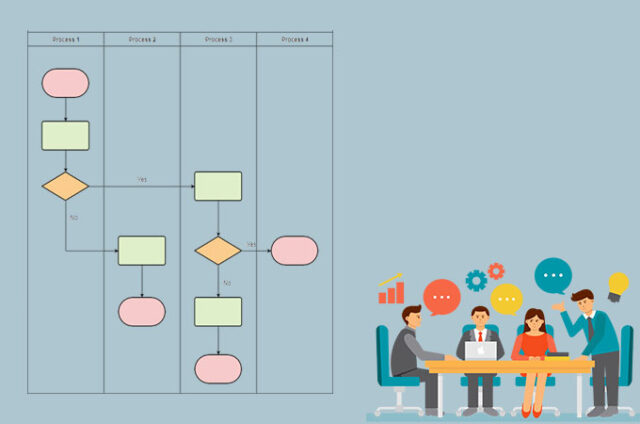
In the current scenario, effective management takes priority over everything else since most of the operations are being handled remotely. Flowcharts have come as a savior for management and have been used extensively across different office spaces and for different applications. But the most important application of flow charts has been efficient workflow management.
The ease with which daily operations can be handled with flowcharts is unparalleled. But if you feel skeptical about flowcharts, we have managed to gather some important ways in which they facilitate workflow management that is mentioned as follows:
1. Easy Visualization

If given a choice, what would you prefer: looking at a flowchart or reading a ten-page report about the responsibilities of different team members? Flowcharts are getting popular because they are easy to understand and save time.
Easy visualization helps the management to demarcate responsibilities without spending a lot of time on any one aspect. This ease of visualization also helps in making changes and improvements in the flowchart and the management process if needed.
2. Can Be Applied as Per the Business Need
Based on the daily operations of the office, you can choose a flowchart for proper workflow management. Different businesses have different approaches to management, which can be adequately processed through a flowchart. There are three flow charts that will help with workflow management on a professional level.
- Basic Flowchart: To facilitate easy communication and understanding in a business, a basic flowchart will help clarify the chain of command. The easy graphic visualization helps create a more transparent workflow management system.

Easy explanation of complex projects is also possible with basic flow charts without requiring any complex alternatives.
For a basic flowchart, a basic workflow analysis is important, which will help recognize the strengths and weaknesses of any program and tackle them accordingly.
- Process Flowchart: A process flow chart goes one step further than a basic flowchart in terms of complexity. The best part about a process flow chart is that the responsibilities of different departments can be managed through a singular approach. A process flow chart works extremely well in projects where different departments are involved and are working towards a common goal. The ease of overview allows all the people involved to understand the professional approach to the project, thereby reducing the chances of miscommunication. Based on the scope, workflow management can work well on both high-level and low-level processes.
- Swim Lane Diagrams: When it comes to work-related responsibilities and project-related details, nothing does it better than a swim lane diagram. Much like a process flowchart, a swim lane diagram can also be used in a project where different departments are collaborating. The main difference, however, is the easy separation of the responsibilities of different departments or singular units.

This demarcation helps with managing drawbacks and deviations and also promotes accountability in an organization.
Since a number of units are working together, understanding the job roles in detail is possible with swim lane diagrams without causing any confusion. When it comes to specifically workflow management, working according to the deadline and tackling time-related problems is possible with the help of swimming diagrams.
3. Takes Variables in Account

Any management executive takes into account the chances that an important aspect of the project they are working on might change at any given time. Based on the client’s preference, there are chances of variation in the approach to completing a particular project. Managing workflow through a flowchart will help incorporate these changes as soon as they occur.
Understanding the changes and incorporating them across departments and teams will be easier in a flowchart where everyone is accountable for a particular aspect of the project.
It will take some research and planning because these are important business decisions, but flowcharts help more than any other means of presenting information will. You will have to use a reliable flow chart creator for your business.
4. Reduces Unproductivity

Flowcharts are made to simplify the process of management and make it easier for everyone to follow a certain chain of command. Delineating responsibilities and promoting accountability is also a major benefit of constructing a flowchart.
Since different aspects of a project are visible in a flow chart, it is easier to see the weak links and issues causing unproductivity. Since these issues can be easily detected, they can be easily resolved. This helps in promoting efficient workflow during daily operations in any workplace.
5. Everyone is Noticed
While managing a big team or a project with several departments working together, management can leave out certain assets. These assets are the employees who have a certain skill set to tackle different responsibilities.
With the help of a flowchart, understanding the strengths and weaknesses of each department can help with the creation of a better plan.
Individuals can be assigned responsibilities within the departments. Since everyone is noticed, they will be given projects suitable to their interest and skill set. This will boost morale and productivity while also making it easier for the management to oversee the progress.
Since individuals are easily noticed through a flowchart, collaboration between departments will also be made easier, and teamwork will be promoted.
6. Easy Elimination

Easy elimination simply means the removal of all the aspects that are holding the business back. Certain habits and practices do more damage than good. Flowcharts allow for their easy detection and help in their removal.
It also boasts productivity and collaboration without causing demoralization. Elimination of mistakes is also possible with flowcharts because accountability is increased at an individual level, so everyone will be doing their best.
The Takeaway
Improving workflow management is the goal of every supervisor in charge of a team or a project. Daily operations will flow seamlessly with the help of a well-made flowchart. Many platforms are available online to help you understand the extent to which a flowchart can help. Make sure you choose the type most suited to your business for easy and effective workflow management.









